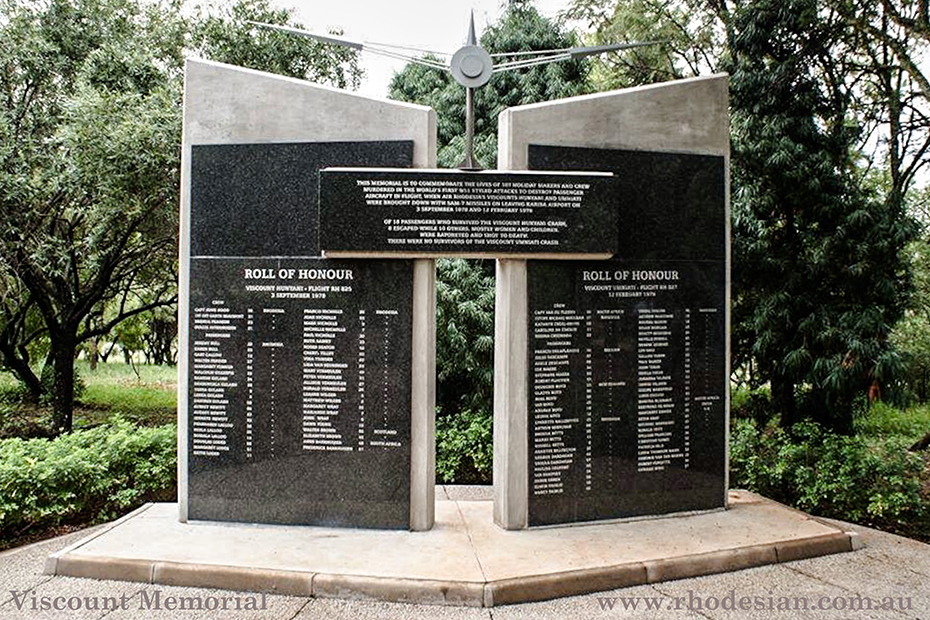In Memoriam - Viscounts
Air Rhodesia Flight RH825 Viscount "Hunyani"
3rd September, 1978
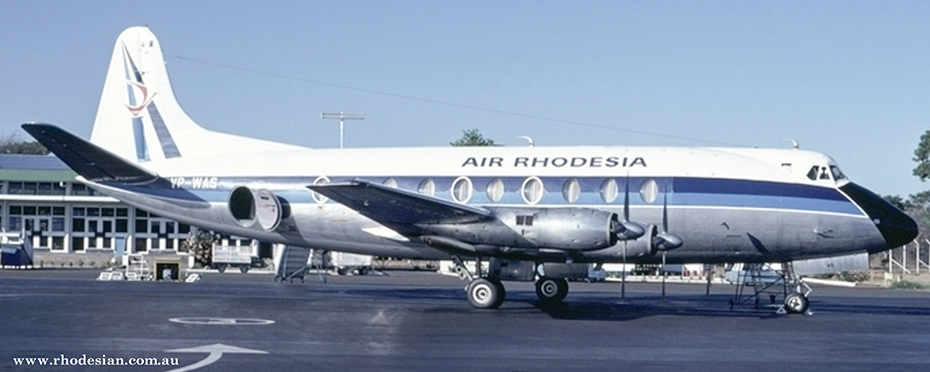
A scheduled passenger flight was shot down by Zimbabwe People's Revolutionary Army (ZIPRA) insurgents on 3 September 1978. The aircraft involved, a Vickers Viscount YP-WAS, named the Hunyani, was flying the last leg of Air Rhodesia's regular scheduled service from Victoria Falls to the capital Salisbury, via the resort town of Kariba.
Soon after Flight 825 took off, a group of ZIPRA guerrillas scored a direct hit on its starboard wing with a Soviet-made Strela 2 surface-to-air infrared homing missile, critically damaging the aircraft and forcing an emergency landing. An attempted belly landing in a cotton field just west of Karoi was foiled by an unseen ditch, which caused the plane to cartwheel and break up. Of the 52 passengers and four crew, 38 died in the crash. Insurgents approached the wreckage, rounded up the 10 survivors they could see and massacred them with automatic gunfire. Three passengers survived by hiding in the surrounding bush, while a further five lived because they had gone to look for water before the guerrillas arrived.
ZIPRA leader Joshua Nkomo publicly claimed responsibility for shooting down the Hunyani on BBC television the same evening, saying the aircraft had been used for military purposes, but denied that his men had killed survivors on the ground.
Pilots:
Captain John Edward Courtenay Hood (36)
First Officer Garth George Beaumont (31)
Air hostesses:
Brenda-Ann Louise Pearson (23)
Dulcie Esterhuizen (21)
Passengers that died:
Mr Fred J. Barkuizen (47), South Africa
Mrs Anns Barkuizen (48), South Africa
Mr Walter Brown (50), Fife, Scotland
Mrs Elizabeth Brown (45), Fife, Scotland
Mr Jeremy Bull (22), Gwelo
Mrs Karen Bull (23), Nurse, Bulawayo
Mr Gary Callow (12), Salisbury
Mr Walter Ferrier (57), Salisbury
Mrs Margaret Ferrier (54), Salisbury
Mr Malcolm Gillespie (22), BSAP, Salisbury
Mr Ramesh Gulabh (34), Centrust Travel, Bulawayo
Mrs Shakuntala Gulabh (28), 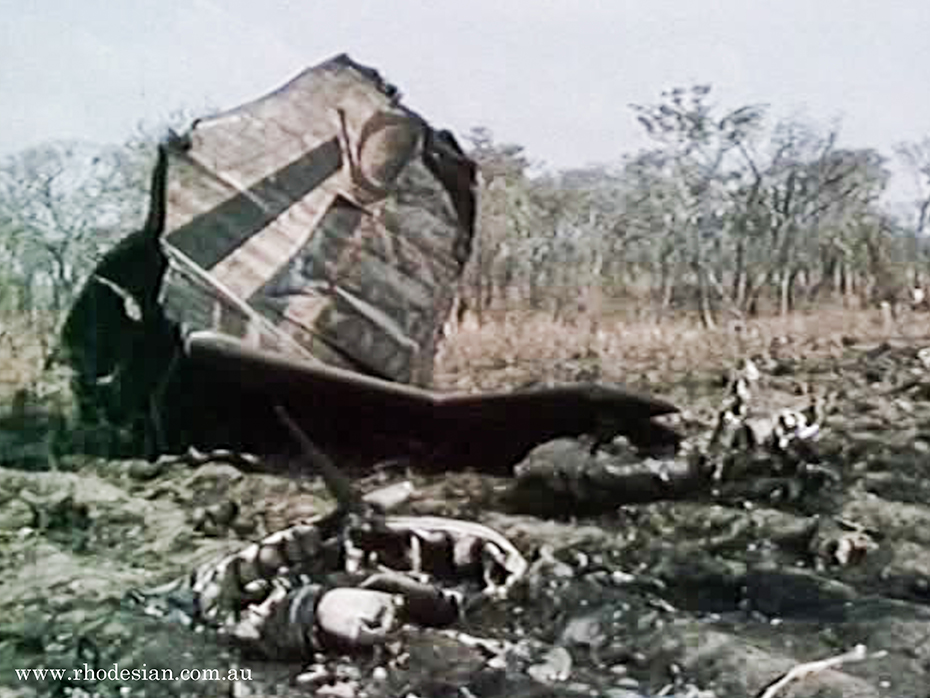
Miss Veena Gulabh (8),
Miss Leena Gulabh (4),
Mrs Dahiben Gulabh (58),
Mr Aubrey Hewitt (64), Attorney, Bulawayo
Mrs Jeannete Hewitt (53), Teacher, Bulawayo
Miss Audrey Hewitt (23),
Mrs Prabhaben Lalloo (38), Milton Park, Salisbury
Miss Meela Lalloo (20),
Miss Romsla Lalloo (11),
Mr Douglas Loder (58), Builder, Bulawayo
Mrs Margaret Loder (51), Headmistress, Carmel School, Bulawayo
Master Keith Loder (11),
Mr Paul Nicholls (30), Salesman, Good Year Tyres, Bulawayo
Mrs Francis Nicholls (26),
Mrs Joan Nicholls (55),
Master Mark Nicholls (9),
Miss Michelle Nicholls (7),
Mrs Ruth Rainey (33), Salisbury
Mr Roger Seaton (42), Salisbury
Miss Cheryl Tilley (20), Rhobank, Salisbury.
Mrs Vina Elizabeth "Betty" Trinder (63), TTC, Bulawayo
Miss Lida van Beuningen (24), Marandellas
Mr Peter Vermeulen (51),
Mrs Mary Vermeulen (49),
Mr Ronald Vermeulen (26), Aircraft Engineer, Salisbury
Mrs Alison Vermeulen (27), Barclays Bank, Salisbury
Matthew Wilger (8), Bulawayo
Miss Leanne Wilger (4), Bulawayo
Mrs Margaret Wray (55), Bindura
Miss Marianne Wray (7), Bindura
Master John Wray (9), Bindura
Miss Dawn Young (19), BSAP, Salisbury
Survivors:
Dr Cecil McLaren
Mrs Sharon Cole
Miss Tracey Cole (4)
Mr Robert Hargreaves (28)
Mrs Shannon Hargreaves (18)
Mr Tony Hill (39)
Mr Hans Hanson (35)
Mrs Diane Hanson (31)
Press/Web reports of Viscount "Hunyani" tragedy
Air Zimbabwe staff
The Viscount was commanded by Captain John Eric Courtenay Hood (36), who was born in Bulawayo and educated at Allan Wilson School. Captain Hood, who has two daughters, aged 10 and three, from a previous marriage, recently remarried. His wife’s name is Diana.
Captain Hood joined Central African Airways in 1961 as a traffic assistant and became a pilot in 1966 when he gained his commercial licence. In 1967 he gained his airline 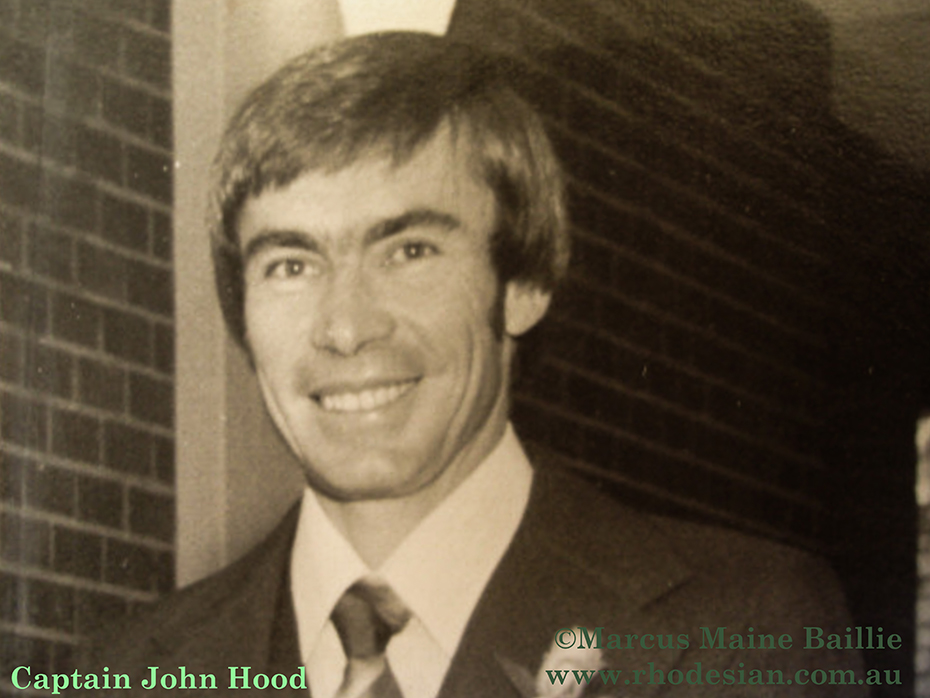 transport pilot’s licence and in 1968 converted to Viscounts.
transport pilot’s licence and in 1968 converted to Viscounts.
He was put in temporary command of DC-3s in 1969 and in 1970 was put in command of Viscounts. He also served with the Rhodesian Air Force on a voluntary basis. He had clocked about 8,000 flying hours.
First Officer Garth George Beaumont (31) was born in Florida, South Africa but schooled in Rhodesia. He was single. In 1974 he joined Air Rhodesia with a commercial pilot’s licence and converted to Viscounts. The same year he gained his airline transport pilot’s licence. First Officer Beaumont had clocked about 4,000 hours.
Air Hostess Miss Dulcie Esterhuizen (21), was born in Bulawayo and attended Northlea School. She previously worked for Rhodesia Railways and a finance house in Bulawayo. The other air hostess, Miss Brenda-Ann Louise Pearson (23) was born in Salisbury and went to Marandellas High School.
Missile attack
Air Rhodesia flight Rh825 was operating the daily scheduled flight from Kariba to Salisbury. The four-engine Viscount which took off from Kariba Airport at 5.10 in the afternoon of the 3rd of September 1978 was carrying a crew of four and fifty-two passengers, most of whom had been week ending at the lakeside holiday resort, site of the spectacular dam which spans the Zambezi and thus joins Rhodesia to Zambia.
Despite intermittent rocket and mortar attacks from Zambia, Kariba had continued to flourish, with hotel bookings only 11 per cent down on the peak year, 1972. Water-skiing, sailing, fishing and the proximity of abundant game - all this brought tourists and weekenders to the Cutty Sark Hotel or the Arabic-style Caribbea Bay Hotel with its lakeside boathouse and lush bougainvillea.
Dr Cecil McLaren was returning to Salisbury after a forty-eight-hour spell of duty as visiting dentist to the Central African Generating Authority staff responsible for running the great dam. This stint was a medical man's version of military call-up and his fifty-ninth take-off from Kariba. One of the last to board the plane, he noticed a spare seat at the back next to a woman and her 4-year-old daughter. He took it. The Viscount Hunyani (named after one of Rhodesia's major rivers) gained altitude at the normal rate, crossed the waters of the bright-blue lake, and headed over the remote, sparsely populated bush of the Urungwe TTL. The no-smoking lights went out as McClaren reached for his cigarettes.
At that moment, five minutes out of Kariba, the plane suddenly lurched, there was a loud bang and the inner starboard engine burst into flames. Ground control received a distress call from the Hunyani: the two starboard engines had failed.
The pilot, Captain John Hood, was heard to call out on his radio: "I can't ... they're going like f..." followed by the words "Mayday. Mayday, Rhodesia 825 I have lost both starboard engines. We are going in."
'I was in no doubt we'd been hit by a heat-seeking missile,' says McLaren, who noted the aircraft's movements during the grim minutes that followed the explosion. It turned ninety degrees from east to due south, then plunged into a rapid descent. Although the air hostesses gallantly made sure that every passenger was strapped in there was what MacLaren describes as 'a certain amount of panic'. 'There was panic in the plane the moment we all knew that the two engines were on fire. A lot of people jumped up. One fellow ahead of me was trying to get through one of the windows as the plane nose-dived.' It was the men who lost their nerve: one man rushed up and down the aisle shouting for a fire extinguisher.
Survivors estimate it was about five minutes between the explosion and the impact with the ground. "It felt as if the plane would break up before we hit. It was going at a heck of a speed," Mr Hill said.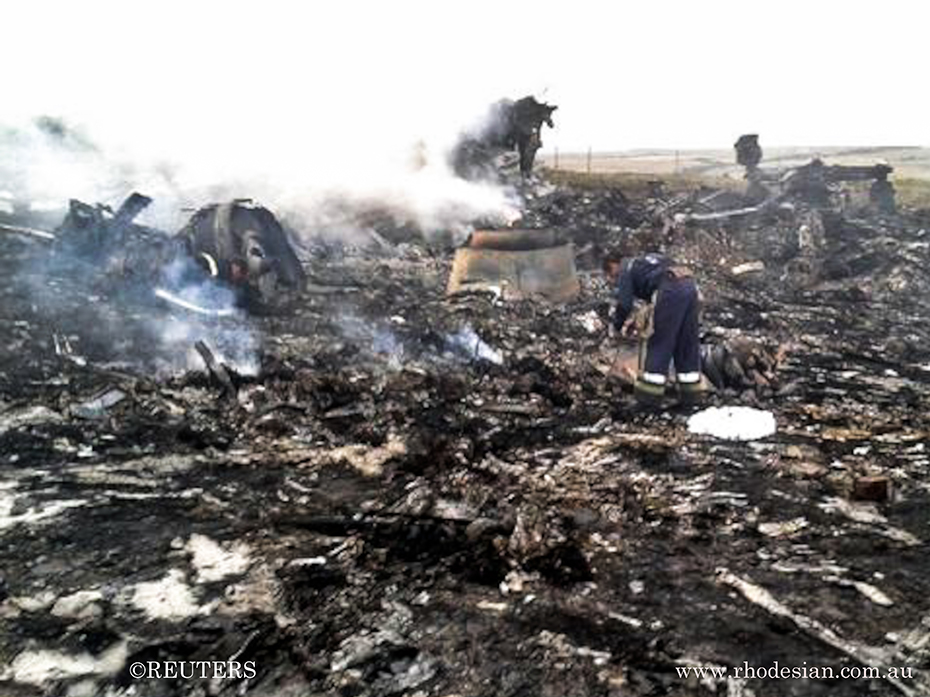
On the flight deck Capt. Hood managed to keep control of the plane as it fell, aiming its nose for a large clearing in the bush. This was a cotton field in the Urungwe Tribal Trust Land, 50 miles west of Karoi within the Whamira Hills - a range of granite kopjes, whose name in local Shona means "you have stopped". The passengers received the pilot's last instruction: 'Brace yourselves for impact!' McLaren heard the fuselage and wings scraping against the tops of trees and then the wheels touched down quite smoothly and it seemed they were going to have a fantastic escape. But the centre of the cotton-field was penetrated by a wide irrigation ditch; as the wheels hit it the plane cart-wheeled and exploded. When the wreckage finally came to a halt McLaren was upside-down five or six rows from the back and flames were threatening to engulf them from the front of the plane. He tried to open a window but the handle broke in his hands. 'We hit the ground with terrific impact. I landed upside down with my mouth full of earth. The broken plane acted like a scoop scooping up dirt'
Even so he managed to release 4-year-old Tracey Cole from her seat-belt and somehow led the child and her mother, Mrs Sharon Cole, out of a hole in the fuselage. "I really don't know what exactly happened after that in proper sequence. I saw a gap in the wreckage through which one could get through. I shouted "Sharon, get your seat belt loose." She hadn't done that. Somehow Sharon followed me through taking Tracy with her."
The missile hit and crash is described by newlywed, Mr Robert Hargreaves (28) from Hunters Hill works for Risco who was returning from his honeymoon at Kariba. He described the events leading to the crash landing. "I had ordered a vodka and tonic from the hostess and she was about to serve the people in the seats in front of us. I told Shannon (18) to take a last look at Kariba and suddenly there was a noise as if we had dropped into an air pocket."
"The engine on our side, nearest the plane, burst into flames, and bits of metal were flying past the windows. We could feel the heat of the flames. Shannon was staring at the flames in horror, so I drew the curtain closed and told her to put her head between her knees and hold her ankles.
People were panicking on the plane and one man rushed past me shouting for a fire extinguisher. I felt the impact and the sand all over me and saw the plane break up. After that I remember nothing until I got outside."
Mrs. Hargreaves said her husband had been flung out of his seat and was screaming for her. She shouted to him to get out and found she herself was trapped between two seats and could not move. "It was only when I heard Dr McLaren shouting at Mrs Coles to release her seat belt that I realised this was why I could not get out. Dr McLaren helped me out and Robert crawled out."
The plane was an inferno. Only eighteen out of fifty-six survived the crash, all of them 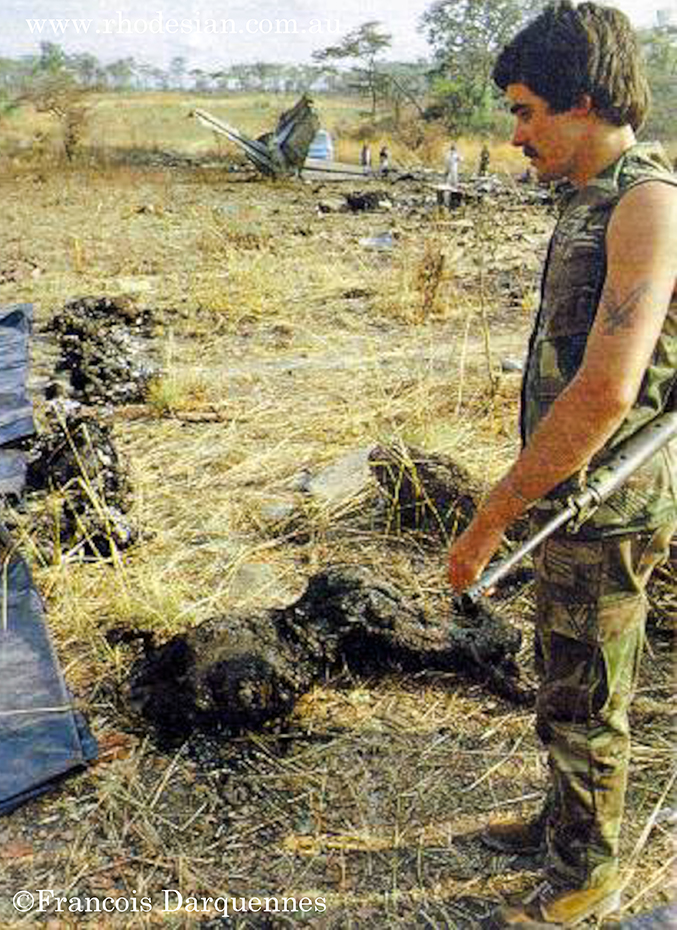 passengers seated in the rear. Among the other survivors was a friend of McLaren's, Tony Hill; between them they did their best to get the living to a distance of some seventy-five metres from the flaming plane, which they expected to explode any minute. The lucky ones ripped off their clothes to make bandages for the injured; Cheryl Tilley, a young Salisbury bank clerk and sister of 15-year-old Colin Tilley, shot down by guerrillas outside his home in January, shredded her colourful cotton dress and began to tend the wounded. It was painfully hot: To Cecil McLaren it seemed that the most urgent task was to find water.
passengers seated in the rear. Among the other survivors was a friend of McLaren's, Tony Hill; between them they did their best to get the living to a distance of some seventy-five metres from the flaming plane, which they expected to explode any minute. The lucky ones ripped off their clothes to make bandages for the injured; Cheryl Tilley, a young Salisbury bank clerk and sister of 15-year-old Colin Tilley, shot down by guerrillas outside his home in January, shredded her colourful cotton dress and began to tend the wounded. It was painfully hot: To Cecil McLaren it seemed that the most urgent task was to find water.
He led a small party towards the smoke of a nearby village: Mrs. Cole and Tracey, as well as Robert and Shannon Hargreaves, who were not only stunned and injured but had lost their slops(Sharon's hand would remain permanently disfigured, while her husband's twisted back and neck would result in months of pain, medical treatment but he never fully recovered.) McLaren himself was wearing lace-up training shoes. Although McLaren, born in Rhodesia of Rhodesian-born parents, spoke Shona fluently, the villagers reacted to their presence with suspicion - indeed hostility. 'When we got there, there was nobody. I spoke in the vernacular. Eventually a door opened and a face appeared, then another door opened. I asked a woman for water. At first she refused. Then she gave us some. We splashed our eyes and faces and went back to the aircraft. A young hostess was lying on the ground saying "please give me some water. Her upper arm was fractured'.
McLaren returned to the village for more. 'The local people were obviously terrified of giving us any help. McLaren possessed and displayed what Mrs. Cole later called 'presence of mind and strength of character'. He is a dark man, Celtic in appearance, shy, courteous and conservative; he speaks in the quiet, clipped Rhodesian manner.
As he led his sad little limping party back towards the plane, carrying more water, the light was fading. His mouth and ears were still full of earth - the fuselage had ploughed up the field after the plane turned over - and he failed to pick up new voices at the scene of the crash. This was the second act of the nightmare: ZIPRA.
Just as they were about to return to the crash site with water for the other survivors they saw tracer bullets go over the village and heard gunfire. "I thought it was ammunition from people's personal weapons in the plane exploding in the heat," said Mrs. Hargreaves. Not realising what had happened they continued towards the plane until after shouting out to the other survivors only an african voice replied, saying: "Come here" "They then opened up on us," said Mr. Hargreaves. "I grabbed Shannon and we ran to a ditch were we spent the night".
Sharon Cole had heard the African voices and shouts of 'Buia lapa' followed by 'Come here!' in English. She continued “Next thing, we saw tracer bullets going over the trees-zip zip . We didn't even hit the deck. Whether this was the Terrs giving warning to the locals or the Terrs shooting at the survivors I couldn't tell."
From a distance McLaren had heard an elderly Englishman, the only male among the captives, shout: 'What do you bastards want now?' A guerrilla replied: 'You have taken our land!' A protracted burst of firing followed - all ten fell dead, including Cynthia Tilley and two girls aged 11 and 4.
At that moment the eighteen surviving whites comprised the following: the five in McLaren's group; Tony Hill, who, after searching for a usable weapon in the wreckage, tore off his white shirt and deliberately ran through a grass fire to cover his escape when a dozen ZIPRA guerrillas showed up; a Mr and Mrs Hansen, who managed to hide themselves in the wreckage, where they covered themselves in dirt and debris and lay still all night; and the remaining ten who were taken captive. At first the guerrillas promised help and water. "They got us together, forcing those who could walk to carry those that couldn't" said Hans Hansen. "Then they opened up with sustained automatic fire. It was the most brutal thing I have ever seen."
That brought the death toll to forty-three.
"We ran," sad Mr Hill. "They kept firing at us until we ducked behind a ridge." The survivors stayed hiding for about two hours. Then the terrorists came back. They raided the aircraft wreckage looting suitcases that were strewn around, while the survivors, hidden in the nearby bush, watched in horror as the terrorists made off "with their hands full." said Mr Hanson. Mr Hanson is sure he heard a terrorist's bayonet as he drove it several times into the body of a seriously wounded survivor who was killed in the first sustained burst of automatic fire two hours previously. Mrs Hansen said, "They were terribly brutal. They took everything." "I can't think how people would do such a thing. They are animals," said Mr Hansen.
McLaren recalls: "I said to Sharon Cole, 'Now we're on our own. 'We all ran off into a river bed and went along it until we reached what looked like the most secluded spot. And there we sat, quietly. Night had fallen by this time." He was unaware that Tony Hill and the Hansens had survived. In fact Hill spent the night in the same ditch as McLaren's party, though neither was aware of the other's presence. Through much of that long, bitterly cold night they listened to the stomping boots of the killers searching for them.
"Tracey was marvelleous. She didn't make the least noise." A single high-pitched, hysterical cry of 'Mummy!' from little Tracey could have ended the story, yet she never made a sound and went to sleep, dressed in a cotton dress, on top of McLaren. McLaren again: 'When I heard an owl hoot and a baboon I shuddered. It was the longest and most terrifying night of my life.' Sharon Cole was in great pain from a huge cut in her shoulder. Dr McLaren said, "Myself and all the others were still in shock but we spent the night all right. For hours we heard footsteps in the bush about us and we kept very quiet. You couldn't have had a better kid with you than Tracey."
"In the morning," Mr Hargreaves said, "we moved up to a higher point where we hid between some rocks and slept for a while. At 10:30 a.m we decided to take our chances and find help."
In the morning, there being no sign of rescue aircraft or helicopters, McLaren decided to head for the main Salisbury-Kariba road. It was here that his coolness in taking note of the Viscount's ninety-degree turn after it was hit paid dividends; the dentist could roughly reckon their present position. It wasn't a happy little party of hikers. The injured Hargreaves shuffled barefoot behind them, their feet torn and blistered; ever-ingenious, McLaren tried to fashion shoes for them out of bark. Tracey had to be carried.
"All along the way, we came across hostile people. No, I wouldn't say hostile - they were obviously very frightened. Whenever I went up to a kraal and asked for help, I would say 'if you can help, okay. If you can't, okay." The villagers along their route remained gloweringly hostile. Towards noon he wondered whether he had made the right decision when they saw paratroopers dropping from Dakotas over the scene of the crash. "Roundabout this time we spotted a Dakota dropping paratroops and I jumped up and waved my arms like mad. But I knew they hadn't a chance of seeing us. The Hargreaves were having trouble. They were lagging behind without shoes. "Sharon and Tracey had gone on ahead along a road and the Hargreaves said I shouldn't worry about them. But I couldn't leave them alone like that - no way. Rob had a damn sore neck and was having trouble keeping his balance. Once he stumbled badly. I made shoes for them out of grass - Sharon and Tracey were sitting waiting for us at the side of the road - when a Land Rover came along." Dr McLaren said the group had "a pretty scary time of it" trudging through the bush and wondering whether the next tribesmen would be terrorists.
But when they did finally hit the main road after walking twelve to fifteen kilometres they were almost instantly picked up by a police Land-Rover.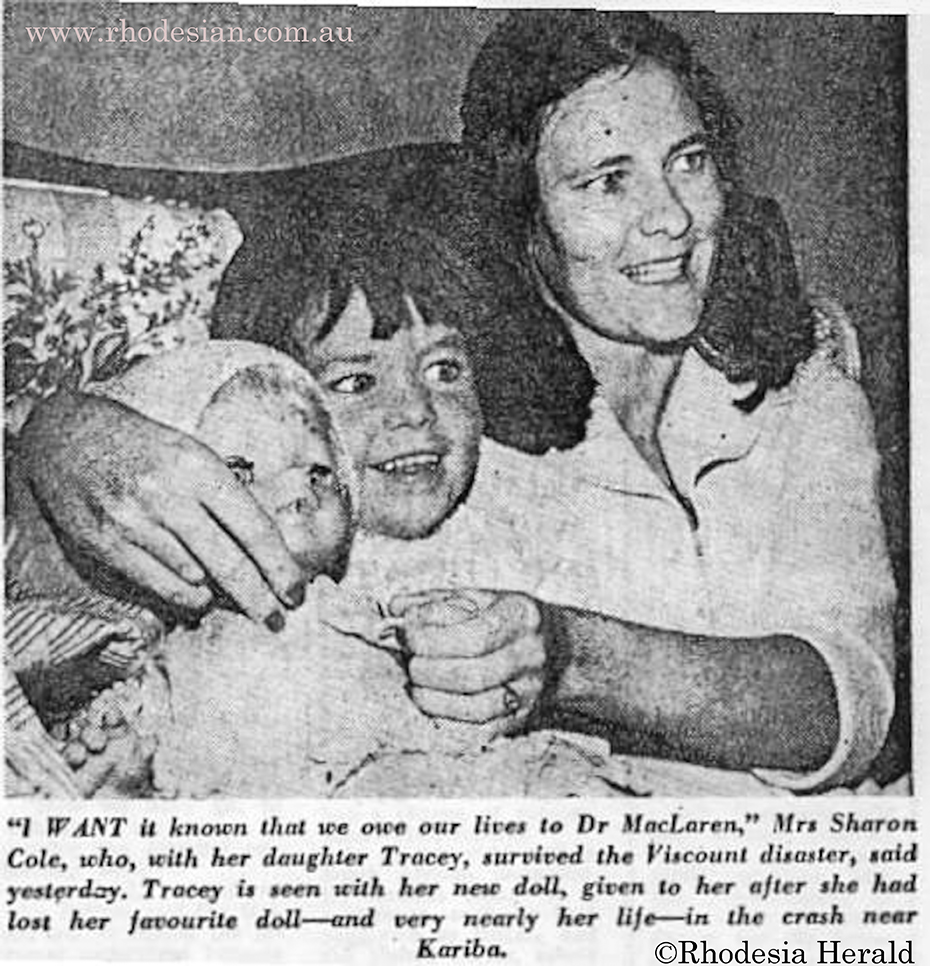
An Alouette helicopter flew them to Karoi. "Alouettes have no door. I felt terrified. I was clinging to the pilot's safety harness enough to strangle him and hating the low level at which we were flying." At Karoi the Special Branch debriefed them and warned them not to discuss what had happened. When he got back to Salisbury, and turned on his TV set, he was astounded to hear Capt. Pat Travers, head of Air Rhodesia, describe the crash as an accident.
It was self-evident to McLaren that the Hunyani had been brought down by a heat-seeking missile.
Not talking to the press presented no problem to a man who harbours the greatest contempt for journalists. One of the sensationalistic Jo'burg papers claimed that the white females had been raped by the terrorists before being murdered, though this was untrue (as was confirmed to me by the doctor who examined the bodies). One local girl reporter told McLaren, 'I'm not here for the truth, I want fiction.' When another reporter, though rebuffed over the phone, showed up on McLaren's doorstep for an interview, the dentist threatened to shoot him if he didn't push off.
How anyone survived Sunday night’s Viscount crash is the question now puzzling all who have seen what little remains of the ill-fated aircraft. The previous day, a team of Salisbury journalists were escorted from Karoi by Police and Army for 83 km through the densely wooded and hilly terrain of the Urungwe Tribal Trust Land to the crash site, about 35 km south-west of Kariba. The Investigating team, headed by Captain John Heap of Air Rhodesia, and Mr. Phil Palmer, chief security adviser to the Department of Civil Aviation, were already at the scene for the second day, sifting through the wreckage of the aircraft, later catalogued and sent to Salisbury for analysis. Captain Heap said it was impossible to say when the cause of the crash would be known. "I don’t want to.jump to any conclusions," he said. The Viscount, piloted by Captain John Hood (36), came down in a cotton field about the size of two football fields divided in half by a donga more than 2 m deep and about 4 m wide.
The plane had clipped the tops off surrounding trees before making what aviation experts at the scene judged to be "a very soft landing". "This shows incredible accuracy by the pilot considering the circumstances" one said. Chief Inspector Mike Farrell, who led the facility trip, added: "It was a fantastic bit of flying to come down the way he did. The pilot must have thought that he was landing in a full field. He could not have known that the donga lay in the middle. He probably had only a couple of minutes to make his decision on where to come down," The Viscount, it appears, cartwheeled after the impact, disintegrated, exploding in a ball of fire, scattering parts of its wings and fuselage up to 200 m around.
Most pieces of the wreckage were small, surrounding the only recognisable parts of the Viscount, the tailplane and a 3 m section of the rear, fuselage. About 20 men, aided by Police and Army, picked through ripped and molten metal and cockpit instruments. Among the debris were the personal belongings of the victims - pathetic reminders of their ill-fated holiday at Kariba.
The bodies of the ten crash survivors later murdered by terrorists were found 10 to 15 meters apart, Mr. Farrell said, which indicated the victims had scattered as the terrorists opened fire on them. At least three of the bodies had been repeatedly bayoneted after death.
Asked by reporters why the local people, some living within a kilometre of the crash, had not come to the assistance of the survivors, Mr Farrell said, "Most would have stayed in their homes because of terrorist intimidation. They were frightened. This area has quite a strong terrorist presence."
By late yesterday afternoon the investigation team had left the scene. First parts of the, wreckage to be scrutinised will probably be the engines, two of which were reported by Captain Hood to have failed. These were removed yesterday - left behind were only charred scraps of the ill-fated Flight 825.
Reports in a South African magazine that rape was commited after the crash have been largely discredited.
Reference: Edited from 'Viscounts in Africa - The Hunyani Disaster' by Rob Rickards.
Kariba Slaughter by Frank Bate, Our Rhodesian Heritage, 2 September, 2010.
Communication from James Ball.
Security forces
A security force spokesman who was a member of an aircraft crew first on the scene said that it seemed that the group of survivors that were shot were in an area of about 10 metres square.
He said that one of the survivors of the crash had torn off her dress to make bandages for the more seriously injured. Among the survivors shot dead were two young girls aged 11 and 4. The shooting took place at 5.45 p.m.
Joshua Nkomo statement from Lusaka
Rhodesian terrorist leader Mr Joshua Nkomo said yesterday his men brought down the Rhodesian airliner near Kariba at the weekend, but denied that his men killed 10 survivors on the ground.
Mr Nkomo, co-leader of the Patriotic Front alliance with Mr Robert Mugabe, said the Air Rhodesia Viscount aircraft was brought down because the planes flying to Kariba on ostensibly civilian flights were being used for ferrying troops and military supplies to the Kariba lakeside area, on the border with Zambia where Mr. Nkomo is based, Iana-Reuter reports.
Mr Nkomo declined to say how the aircraft had been brought down. Only eight of the 56 people aboard survived.
"We brought that plane down, but it is not true that we killed any survivors," Mr Nkomo said. "The Rhodesians have been ferrying military personnel and equipment in Viscounts and we had no reason to believe that this was anything different," he said.
He said his ZIPRA (Zimbabwe People’s Revolutionary Army) was "not interested in killing civilians, but when people start using civilian aircraft how do you know when the plane is up there? The Rhodesians should know this is a military zone," he said.
Mr Nkomo said it was tragic that there had been a massive outcry in the West because white civilians had been killed.
"You forget that the regime kills 30 of our people a day. So the life of a black person is different from a white person? Any European child is supposed to be worth a million blacks,”" Mr Nkomo said. "As far as we are concerned we were bringing down an aircraft that’s being used to ferry military personnel and equipment," he continued.
Asked if the reported downing of the plane marked a turning-point in the six-year-old war he said: "We have said that it is going to be intensified every day, we will make it much more bitter."
View Joshua Nkomo February 1979 interview
The irony is that political analysts at that time started to consider Nkomo to be more of a threat to stability post-Independence than the ZANLA leader, Robert Mugabe.
References: The Hunyani Disaster - A compilation of newspaper articles. Internet.
The Zimbabwe News live: Nkomo insult: ZIPRA commander shoots itself in foot.
The address by Very Rev. John da Costa, Anglican Dean of Salisbury at the Church Service for the victims can be heard here.
Air Rhodesia Flight RH827 Viscount "Umniati"
12th February, 1979

Five months later, two Viscounts departed Kariba within fifteen minutes of each other. The second one landed in Salisbury but Viscount YP-YND had been hit by a heat seeking missile. There were no survivors.
Pilots:
Captain Jan Andre du Plessis (50), South Africa
First Officer Michael Thomas Moolman (37)
Air Hostesses:
Kathryn Jane Creigh-Smith (29)
Caroline Lynette du Chemin (21)
Regina Chigwada (23)
Passengers:
Mrs Lynnette Ballentyne (25), Rhodesia
Mr Arthur Bensusan (66), Gladstone Mine, Arcturus
Mrs Brenda Betts (36), Bulawayo
Mark Betts (11), Bulawayo
Russell Betts (9), Bulawayo
Mrs Annette Billington (35), Rhodesia
Miss Martha Blignaut (37), South Africa
Mr Desmond Boyd (53), New Zealand
Mrs Gladys Boyd (49)
Mr Noel Boyd (26)
Mr Ian Boyd (25), Old Hararians, Salisbury
Miss Andrea Boyd (16)
Miss Leonie Boyd (14)
Mr George Dardagan (44), Dardagans, Banket
Mrs Ursula Dardagan (47).
Miss Margaret "Margo" Davies (35), British Airways air hostess, UK
Mr F. Deleplangue (50), Belgium
Mrs Pauline Delport (26), Rhodesia,
Mr Ian Dempsey (34), Air Rhodesia pilot
Mr Bertrand de Rham (27), Switzerland
Mr Jules Descampe (67), Belgium
Mrs Adele Descampe (66), Belgium
Mr Derek Ebben (59), Rhodesia
Mr Edwin Fairlie (76), Rhodesia
Mrs Nancy Fairlie (66), Rhodesia
Mr William Francois (30)
Mr Christian Gobey (52), Gatooma
Mr Donald Goldin (46), MP, Wankie
Mr Peter Gray (67), UK
Andrew Hardinge (14), Victoria Falls
Mr Michael Harraghy (37), UK
Mr Ron Isitt (55), Liebigs, UK
Mr Stephane Maere (56), Belgium
Mrs IdeMaere (54), Belgium
Lt Andrea "Andy" Mason (32), Army AHQ
Miss Susan E. Morgan (25), Rhodesia
Mr Beauty Muzondo (25), Rhodesia
Mr Robert Plouvier (55), Belgium
Major Neville "Spike" Powell (45), Rhodesia
Mrs Nerene Quinese (32), Norton
Miss Lyn Rees (21), Rhodesia
Miss Gillian Tabor (22), Rhodesia
Mr Paul Tasker (19), Rhodesia
Mr John Teede (54), Rhodesia
Mrs Sheila Teede (54), Rhodesia
Mrs Linda Thomson née Mann (22), British Airways, UK
Mr Henrik van der Merwe (33)
Mrs Joanna Viljoen (53), Rhodesia
Miss Denise Viljoen (17), Rhodesia
Mr Robert "Rob" Virgette (30)
Mrs Deirdre Wakefield (41), Rhodesia
Mr Edward "Ted" Wigg (37), Liebigs Ltd, Bulawayo
Mr Loris Zucchini (58), Liebigs Ltd, Bulawayo
Press report of Viscount "Umniati"
At 6 minutes past 5 in the afternoon of February 1979 a Karoi farmer, John Ashton, looked up, due north, and saw a ball of flame followed by dense smoke falling out of the sky.
Earlier, two busloads of holiday makers had driven from Kariba to the airport in convoy. On arrival they mingled and chatted round the bar and shop, awaiting the order to board the two Viscounts (painted camouflage grey since the Hunyani disaster five months earlier) scheduled to fly them back to Salisbury.
Some felt nervous; others believed the Hunyani had been a one-off fluke; and some were simply accustomed to take risks. Prominent among these was Lt.-Gen. Peter Walls, Commander of Combined Operations, and his wife.
Those issued with red boarding-cards were called first and boarded the "Umniati". Passengers carrying green boarding-cards were informed they would leave fifteen minutes later. Walls was among the latter.
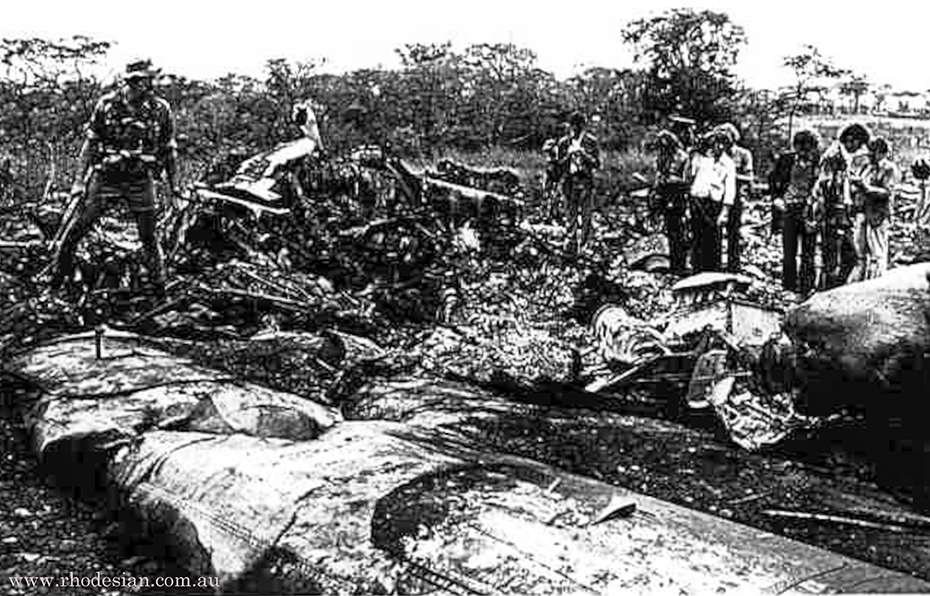 The Umniati took off, heading due east. As it passed overhead a ZIPRA section fired a flare to indicate its flight-path The signal was picked up by a missile crew.
The Umniati took off, heading due east. As it passed overhead a ZIPRA section fired a flare to indicate its flight-path The signal was picked up by a missile crew.
At 6 minutes past 5 the Kariba Control Tower heard the plane's 'mayday mayday' distress call and passengers waiting to board the second Viscount noticed four men racing across the tarmac to a light aircraft. This was the moment that the Karoi farmer, John Ashton, looked up and saw a ball of flame falling from the sky.
Six months earlier Captain Hood had managed to bring the Hunyani down in a semi-controlled landing, but the Umniati, hit in the jet pipe of the inner port engine by a Sam 7, burst into flame and plummeted like a stone into a ravine in the Vuti African Purchase Area, where it burnt for six hours, incinerating almost all of the fifty-four passengers and five crew members beyond recognition.
Captain Jan du Plessis, formerly of the South African Air Force and a veteran of the Korean War, stood no chance. (He had recently lost his son Leon in a Rhodesian Air Force flying accident.)
The second Viscount took off in a different direction. It circled tightly over the lake, gaining altitude - the missile ceiling is 3,000 metres - and spiralling beyond danger.
The last flight of the "Umniati"
The Umniati Viscount will fly no more,
Like Hunyani her sister, now lost to the war,
Russian Sam sevens, operated by scum,
All fifty nine lives lost; and no battle won.
“Civilians too, must pay for our cause,
It’s not only soldiers who die in the wars”
These were the words on Satan’s black lips,
Aiming the heat seeking silicon chips.
Special Air Services were first at the scene,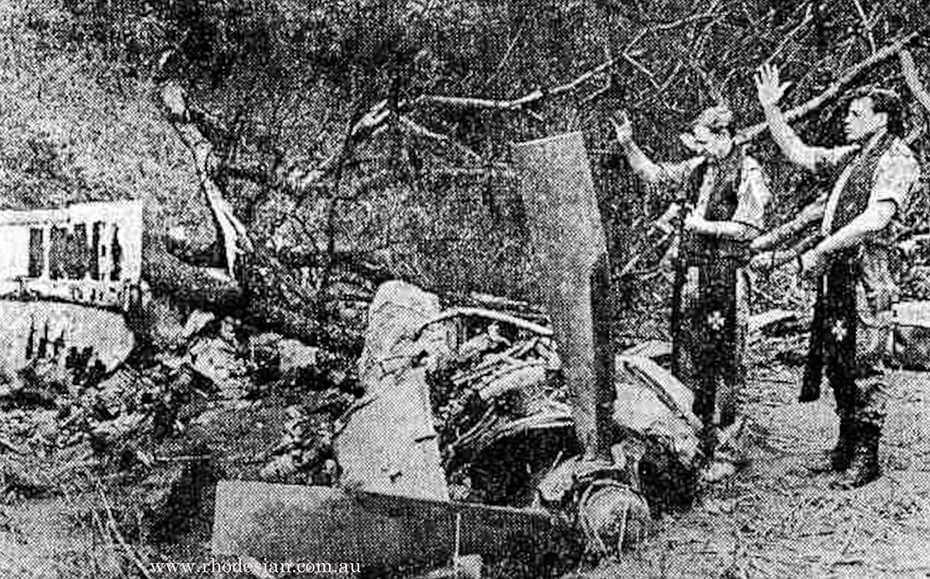
Quite unprepared for this carnage obscene.
Scattered remains of those precious lives,
Sisters and brothers, husbands and wives.
Follow up operations were swift and precise,
Squeezing the terrorists in the jaws of their vice,
Elite airborne soldiers come to settle the score,
Satan’s crass terrorist would kill no more.
This was Rhodesia’s own ‘Nine Eleven’,
Heinously foul, by a rocket Sam seven.
No condemnation from UN world power,
No worldwide protest, in our darkest hour.
Let us never forget those left behind,
Mourning our beloved who suffered and died,
The SAS squadron who were put to the test,
Witnessing a scene so macabre, so grotesque.
How will we ever make sense of it all,
Rhodesia to Zimbabwe, it’s rise and it’s fall,
Too many have sacrificed life’s ultimate price,
One bowl of gold nuggets, for one bowl of rice.
Alf Hutchison “Sounds of distant Drums”
The memorial at Voortrekker Monument & Heritage Site
The memorial was unveiled at an Inauguration Service to the west of the Voortrekker Monument on 2nd September, 2012. 200 people attended. Dr Cecil MacLaren had passed away in New Zealand in 1998. Tragically, Robert Hargreaves never recovered from the trauma from the crash and had taken his life.
This tragedy touched so many Rhodesians and still does. Informal gatherings take place at the Viscount Memorial but a formal service is held every four years. The next one is to be held on 3 September, 2016.
